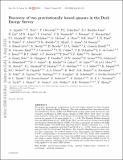Discovery of two gravitationally lensed quasars in the Dark Energy Survey
Author(s)
Agnello, A.; Treu, T.; Ostrovski, F.; Buckley-Geer, E. J.; Lin, H.; Auger, M. W.; Courbin, F.; Fassnacht, C. D.; Frieman, J.; Kuropatkin, N.; Marshall, P. J.; McMahon, R. G.; Meylan, G.; More, A.; Suyu, S. H.; Rusu, C. E.; Finley, D.; Abbott, T.; Abdalla, F. B.; Schechter, Paul L; ... Show more Show less
DownloadThaler_Discovery of two.pdf (789.4Kb)
OPEN_ACCESS_POLICY
Open Access Policy
Creative Commons Attribution-Noncommercial-Share Alike
Terms of use
Metadata
Show full item recordAbstract
We present spectroscopic confirmation of two new gravitationally lensed quasars, discovered in the Dark Energy Survey (DES) and Wide-field Infrared Survey Explorer (WISE) based on their multiband photometry and extended morphology in DES images. Images of DES J0115−5244 show a red galaxy with two blue point sources at either side, which are images of the same quasar at zs = 1.64 as obtained by our long-slit spectroscopic data. The Einstein radius estimated from the DES images is 0.51 arcsec. DES J2146−0047 is in the area of overlap between DES and the Sloan Digital Sky Survey (SDSS). Two blue components are visible in the DES and SDSS images. The SDSS fibre spectrum shows a quasar component at zs = 2.38 and absorption by Mg ii and Fe ii at zl = 0.799, which we tentatively associate with the foreground lens galaxy. Our long-slit spectra show that the blue components are resolved images of the same quasar. The Einstein radius is 0.68 arcsec, corresponding to an enclosed mass of 1.6 × 1011 Mȯ. Three other candidates were observed and rejected, two being low-redshift pairs of starburst galaxies, and one being a quasar behind a blue star. These first confirmation results provide an important empirical validation of the data mining and model-based selection that is being applied to the entire DES data set.
Date issued
2015-12Department
Massachusetts Institute of Technology. Department of PhysicsJournal
Monthly Notices of the Royal Astronomical Society
Publisher
Oxford University Press
Citation
Agnello, A.; Treu, T.; Ostrovski, F.; Schechter, P. L.; Buckley-Geer, E. J.; Lin, H. and Auger, M. W. et al. “Discovery of Two Gravitationally Lensed Quasars in the Dark Energy Survey.” Monthly Notices of the Royal Astronomical Society 454, no. 2 (October 1, 2015): 1260–1265.
Version: Original manuscript
ISSN
0035-8711
1365-2966